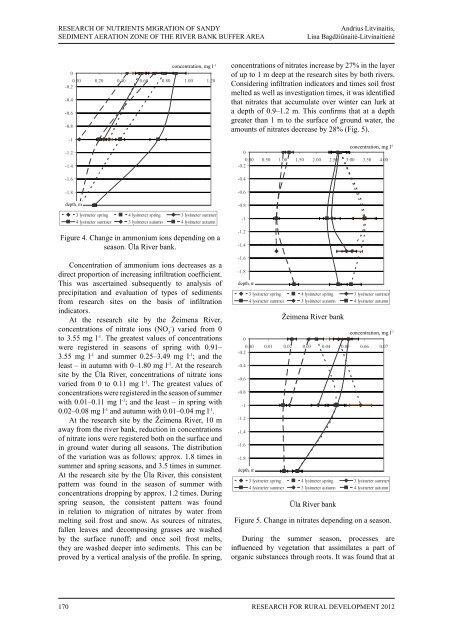RESEARCH FOR
RESEARCH FOR
RESEARCH FOR
You also want an ePaper? Increase the reach of your titles
YUMPU automatically turns print PDFs into web optimized ePapers that Google loves.
<strong>RESEARCH</strong> OF NUTRIENTS MIGRATION OF SANDY<br />
SEDIMENT AERATION ZONE OF THE RIVER BANK BUFFER AREA<br />
0<br />
0.00<br />
-0.2<br />
0.20 0.40 0.60 0.80 1.00 1.20<br />
-0.4<br />
-0.6<br />
-0.8<br />
-1<br />
-1.2<br />
-1.4<br />
-1.6<br />
-1.8<br />
depth, -2 m<br />
concentration, concentration, mg mg/l l-1 3 lysimeter spring 4 lysimeter spring 3 lysimeter summer<br />
4 lysimeter summer 3 lysimeter autumn 4 lysimeter autumn<br />
Figure 4. Change in ammonium ions depending on a<br />
season. Ūla River bank.<br />
Concentration of ammonium ions decreases as a<br />
direct proportion of increasing infiltration coefficient.<br />
This was ascertained subsequently to analysis of<br />
precipitation and evaluation of types of sediments<br />
from research sites on the basis of infiltration<br />
indicators.<br />
At the research site by the Žeimena River,<br />
- concentrations of nitrate ions (NO ) varied from 0<br />
3<br />
to 3.55 mg l-1 . The greatest values of concentrations<br />
were registered in seasons of spring with 0.91–<br />
3.55 mg l-1 and summer 0.25–3.49 mg l-1 ; and the<br />
least – in autumn with 0–1.80 mg l-1 . At the research<br />
site by the Ūla River, concentrations of nitrate ions<br />
varied from 0 to 0.11 mg l-1 . The greatest values of<br />
concentrations were registered in the season of summer<br />
with 0.01–0.11 mg l-1 ; and the least – in spring with<br />
0.02–0.08 mg l-1 and autumn with 0.01–0.04 mg l-1 .<br />
At the research site by the Žeimena River, 10 m<br />
away from the river bank, reduction in concentrations<br />
of nitrate ions were registered both on the surface and<br />
in ground water during all seasons. The distribution<br />
of the variation was as follows: approx. 1.8 times in<br />
summer and spring seasons, and 3.5 times in summer.<br />
At the research site by the Ūla River, this consistent<br />
pattern was found in the season of summer with<br />
concentrations dropping by approx. 1.2 times. During<br />
spring season, the consistent pattern was found<br />
in relation to migration of nitrates by water from<br />
melting soil frost and snow. As sources of nitrates,<br />
fallen leaves and decomposing grasses are washed<br />
by the surface runoff; and once soil frost melts,<br />
they are washed deeper into sediments. This can be<br />
proved by a vertical analysis of the profile. In spring,<br />
concentrations of nitrates increase by 27% in the layer<br />
of up to 1 m deep at the research sites by both rivers.<br />
Considering infiltration indicators and times soil frost<br />
melted as well as investigation times, it was identified<br />
that nitrates that accumulate over winter can lurk at<br />
a depth of 0.9–1.2 m. This confirms that at a depth<br />
greater than 1 m to the surface of ground water, the<br />
amounts of nitrates decrease by 28% (Fig. 5).<br />
0.00<br />
-0.2<br />
0.50 1.00 1.50 2.00 2.50 3.00 3.50 4.00<br />
depth, -2 m<br />
170 ReseaRch foR RuRal Development 2012<br />
0<br />
-0.4<br />
-0.6<br />
-0.8<br />
-1<br />
-1.2<br />
-1.4<br />
-1.6<br />
-1.8<br />
0<br />
-0.4<br />
-0.6<br />
-0.8<br />
-1<br />
-1.2<br />
-1.4<br />
-1.6<br />
-1.8<br />
depth, -2 m<br />
Andrius Litvinaitis,<br />
Lina Bagdžiūnaitė-Litvinaitienė<br />
concentration, mg mg/l l-1 3 lysimeter spring 4 lysimeter spring 3 lysimeter summer<br />
4 lysimeter summer 3 lysimeter autumn 4 lysimeter autumn<br />
Žeimena River bank<br />
concentration, mg mg/l l-1 0.00<br />
-0.2<br />
0.01 0.02 0.03 0.04 0.05 0.06 0.07<br />
3 lysimeter spring 4 lysimeter spring 3 lysimeter summer<br />
4 lysimeter summer 3 lysimeter autumn 4 lysimeter autumn<br />
Ūla River bank<br />
Figure 5. Change in nitrates depending on a season.<br />
During the summer season, processes are<br />
influenced by vegetation that assimilates a part of<br />
organic substances through roots. It was found that at


